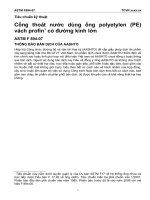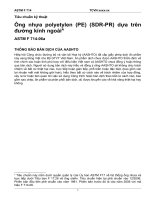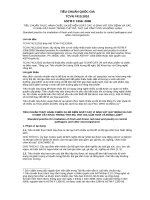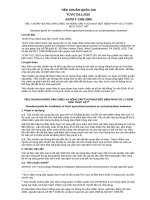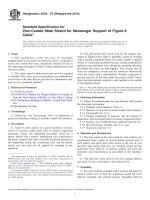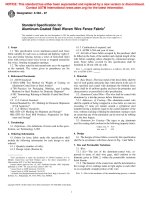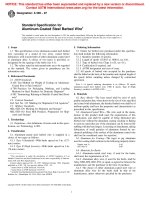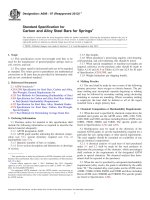Astm astm f 1062 97 (2013)
Bạn đang xem bản rút gọn của tài liệu. Xem và tải ngay bản đầy đủ của tài liệu tại đây (82.61 KB, 3 trang )
Designation: F1062 − 97 (Reapproved 2013)
Standard Test Method for
Verification of Ski Binding Test Devices1
This standard is issued under the fixed designation F1062; the number immediately following the designation indicates the year of
original adoption or, in the case of revision, the year of last revision. A number in parentheses indicates the year of last reapproval. A
superscript epsilon (´) indicates an editorial change since the last revision or reapproval.
F1064 Practice for Sampling and Inspection of Complete
and Incomplete Alpine Ski/Binding/Boot Systems in
Rental Applications
1. Scope
1.1 This test method defines procedures to determine agreement between a standard apparatus for measuring the release
moments of ski bindings and a test device of unspecified
design.
3. Terminology
1.2 This test method also covers procedures for checking
agreement between individual devices of identical but unspecified design, intended for determining the release moments of
ski bindings.
3.1 Definitions—The terms and abbreviations used in this
document are defined in accordance with Test Method F504,
Specification F1061, Terminology E456, Practices E4, and
Practice E74.
1.3 Values expressed in newton meters, newtons, and centimeters are to be regarded as the standard.
3.2 Definitions of Terms Specific to This Standard:
3.2.1 a—difference between the calibration of the specific
device tested for agreement with an instrument of the type
described in Test Method F504 and the calibration of an
individual device of the same design.
1.4 Values expressed in units of torque may be converted to
the appropriate force values when devices which indicate force
are used.
1.5 This standard does not purport to address all of the
safety concerns, if any, associated with its use. It is the
responsibility of the user of this standard to establish appropriate safety and health practices and determine the applicability of regulatory limitations prior to use.
3.2.2 d—agreement between the test device and the standard
apparatus described in Test Method F504 and Section 9 of this
test method.
3.2.3 r—imprecision of the device tested.
3.2.4 operating range (OR)—the portion of the full range of
the device which may be employed in accordance with
Practices F1063 and F1064. OR shall be defined by the user in
accordance with the Inspection section of Annex 2 of Practices
F1063 and F1064.
2. Referenced Documents
2.1 ASTM Standards:2
E4 Practices for Force Verification of Testing Machines
E29 Practice for Using Significant Digits in Test Data to
Determine Conformance with Specifications
E74 Practice of Calibration of Force-Measuring Instruments
for Verifying the Force Indication of Testing Machines
E456 Terminology Relating to Quality and Statistics
F504 Test Method for Measuring the Quasi-Static Release
Moments of Alpine Ski Bindings
F1061 Specification for Ski Binding Test Devices
F1063 Practice for Functional Inspections and Adjustments
of Alpine Ski/Binding/Boot Systems
3.2.5 recommended operating range (ROR)—the portion of
the full range of the test device that is in accordance with
Proposed Specification P 193.
3.2.6 reference binding—a binding or group of bindings
used in the verification of a test device.
3.2.7 standard apparatus—laboratory equipment including
a test frame and instrumentation used as the basis for comparison with the test device.
3.2.8 test device—a machine for determining the release
moments of ski/boot/binding systems.
1
This test method is under the jurisdiction of ASTM Committee F27 on Snow
Skiing and is the direct responsibility of Subcommittee F27.10 on Binding Test
Procedures.
Current edition approved July 1, 2013. Published August 2013. Originally
approved in 1988. Last previous edition approved in 2008 as F1062 – 97 (2008).
DOI: 10.1520/F1062-97R13.
2
For referenced ASTM standards, visit the ASTM website, www.astm.org, or
contact ASTM Customer Service at For Annual Book of ASTM
Standards volume information, refer to the standard’s Document Summary page on
the ASTM website.
3.3 Symbols:
3.3.1 Mz— a moment in a horizontal plane as shown in the
figure in Test Method F504, which illustrates terminology
relating to the boot/ski system.
3.3.2 My— a moment in a vertical plane with the ski as
shown in the figure in Test Method F504, which illustrates
terminology relating to the boot/ski system.
Copyright © ASTM International, 100 Barr Harbor Drive, PO Box C700, West Conshohocken, PA 19428-2959. United States
1
F1062 − 97 (2013)
temperature over the course of the test by more than 2°C and
humidity by more than 5 %.
4. Significance and Use
4.1 Results obtained by this test method can be used to
determine the suitability of specific test device designs in
measuring the release moments of ski/boot/binding systems.
8. Procedure
8.1 Perform five repetitions of the following procedure:
8.1.1 Using the standard apparatus, perform three repetitions of a test required for Type I, II, or III devices, and perform
three repetitions of the analogous test on the test device.
8.1.1.1 Randomly select which series of three tests will be
conducted first.
8.1.1.2 From the Table on Load Application of Test Method
F504, use tests 1.1 and 1.2 for Type I devices, tests 2.1 and 2.2
(if appropriate) for Type II devices and tests as specified by the
test device manufacturer for Type III devices.
8.1.1.3 Follow the test device manufacturer’s instructions
for conducting analogous tests.
4.2 This test method provides a means by which manufacturers of test devices and manufacturers of releasable ski
bindings can provide compatible instructions to facilities which
perform the final inspection of the complete boot/binding/ski
system prior to use.
4.3 This test method is not appropriate for determining
precision between operators.
5. Apparatus
5.1 Test Ski—The test ski shall meet the stiff ski definition in
the portion of the Apparatus Section of Test Method F504
pertaining to skis and bindings.
8.2 Perform the procedure in 8.1-8.1.1.3 at the beginning,
middle, and end of the ROR. If the reference binding cannot be
adjusted for release over the full ROR, perform the test(s) at 10
or 90 % of the limit(s) of the reference binding as appropriate.
8.2.1 Immediately before and after each cycle of
8.1-8.1.1.3, measure and record the calibration of the test
device, in accordance with the method specified by the test
device manufacturer. Use a dead weight or instrument which is
accurate to within 1 %.
5.2 Test Sole—The test sole shall meet the requirements in
the portion of the Apparatus Section of Test Method F504
pertaining to boots, and shall be of a design compatible with
the reference binding. The test sole may be modified to
establish necessary interfaces with the standard apparatus and
test device providing such modifications do not influence the
proper function of the reference binding.
5.3 Test Frame and Instrumentation:
5.3.1 All apparatus shall meet the portions of the Apparatus
Section of Test Method F504 pertaining to cable,
instrumentation, and load application.
5.3.2 Devices shall be employed to monitor cable tension.
Differences of more than 5 % in cable tension at the attachment
points with the ski may significantly bias results.
NOTE 2—Practice E74 may be used as a general guide for selecting
calibration devices.
8.2.1.1 Check the calibration of the test device at both
extremes and the middle of the ROR and at 10 and 90 % of full
scale unless such values fall within the ROR.
8.3 Repeat the steps given in 8.2 for all appropriate tests
listed in 8.1.1.2.
5.4 Reference Binding—The reference binding shall be of
the type specified by the manufacturer of the test device.
8.4 Make and record all readings to a resolution of one half
the smallest scale division of the test device unless otherwise
specified in the operating instructions for the test device. Read
the data recorded by the standard apparatus to a significance of
2 % of the lower limit of the ROR.
6. Preparation of Apparatus
6.1 Mount the reference binding on the test ski and fit to the
test sole in accordance with the specification of the binding
manufacturer.
9. Calculation
6.2 Lubricate all interfaces within the reference binding and
all areas of sliding contact between test sole and binding with
a compatible grease.
9.1 Determine the middle quantitative value (median) of
each test series (three repetitions of each test constitute a
series) and use it for all calculations.
6.3 Calibrate the binding in tests 1.1 and 2.1 (and 2.2 if
appropriate) of Test Method F504, using the standard apparatus.
6.3.1 The calibration of the reference binding shall be as
specified by the test device manufacturer.
9.2 Calculate the mean and standard deviations for the test
device and the standard apparatus in each cycle of 8.1.
9.2.1 Calculate the standard deviation, in percent, as follows:
NOTE 1—Practices E4 and Practice E74 may be used as general guides
in developing calibration procedures.
s5
6.4 Condition the binding prior to each test series by
causing the mechanism to release three times in the appropriate
direction.
0.43R
3 100
X¯
where:
X¯ = mean, and
R = range of observations.
7. Conditioning
9.3 Calculate d for each cycle of 8.1, in percent, as follows:
7.1 Unless the test device is to be used at other than normal
room temperatures, conduct all tests at a temperature of 23 6
5°C and a relative humidity of 50 6 5 %. Do not vary
d5
X¯ td 2 X¯ sa
X¯
sa
2
F1062 − 97 (2013)
10.1.1 Name of the calibrating agency,
10.1.2 Date of verification,
10.1.3 Test device description and serial number,
10.1.4 Reference binding,
10.1.5 Temperature at which tests were conducted.
10.1.6 ROR, d, and r for all test series listed by test method,
and the point in the ROR, (lower, middle, or upper), and
10.1.7 All calibration curves and their equations.
where:
sa
= standard apparatus, and
td
= test device.
9.4 Calculate r for each cycle of 8.1, in percent, as follows:
r 5 =s 2sa 2 S 2td
if S sa .S td,
then r 5 0
9.5 Plot a calibration curve for each cycle of 8.3 in terms of
the data recorded in 8.2.1. By the least squares method, fit a
second order polynomial equation to the data.
11. Precision and Bias
10. Report
10.1 Prepare a clear and complete report of each verification
of a test device including:
11.1 Repeatability and reproducibility will be determined.
11.2 The bias of this test method has not been determined.
ANNEX
(Mandatory Information)
A1. CALIBRATION OF SKI BINDING TEST DEVICES
A1.1 Scope
a5
Md 2 Mt
3 100
Mt
A1.1.1 This test method covers procedures for checking
agreement between individual devices of identical but unspecified design, intended for determining the release moments of
ski bindings.
where:
Md = moment indicated by the test device, and
Mt = moment derived from the calibration curve.
A1.2 Procedure
A1.4 Report
A1.2.1 From the calibration curves, determine the loads
which correspond to the lower and upper limits and middle of
the ROR.
A1.4.1 Prepare a clear and complete report of the calibration
of each test device including:
A1.4.1.1 Name of calibrating agency,
A1.4.1.2 Date of calibration,
A1.4.1.3 Test device description, serial number, and
location,
A1.4.1.4 Test loads, test points and calibration method, and
A1.4.1.5 ROR, and al, am, au for each classification,
NOTE A1.1—Averaging calibration curves derived for positive and
negative moments may be appropriate.
A1.2.2 By the method employed in 8.2.1 and using the
loads determined in A1.2.1, check the calibration of the test
device and record the values indicated by the specific device at
each test point in the ROR.
A1.3 Calculation
where:
l
= lower,
m = middle, and
u
= upper.
A1.3.1 For upper, middle, and lower test points, calculate
the difference, in percent, of a between the moment derived
from the calibration curve and the moment indicated by the test
device, using the following equation:
ASTM International takes no position respecting the validity of any patent rights asserted in connection with any item mentioned
in this standard. Users of this standard are expressly advised that determination of the validity of any such patent rights, and the risk
of infringement of such rights, are entirely their own responsibility.
This standard is subject to revision at any time by the responsible technical committee and must be reviewed every five years and
if not revised, either reapproved or withdrawn. Your comments are invited either for revision of this standard or for additional standards
and should be addressed to ASTM International Headquarters. Your comments will receive careful consideration at a meeting of the
responsible technical committee, which you may attend. If you feel that your comments have not received a fair hearing you should
make your views known to the ASTM Committee on Standards, at the address shown below.
This standard is copyrighted by ASTM International, 100 Barr Harbor Drive, PO Box C700, West Conshohocken, PA 19428-2959,
United States. Individual reprints (single or multiple copies) of this standard may be obtained by contacting ASTM at the above
address or at 610-832-9585 (phone), 610-832-9555 (fax), or (e-mail); or through the ASTM website
(www.astm.org). Permission rights to photocopy the standard may also be secured from the ASTM website (www.astm.org/
COPYRIGHT/).
3
